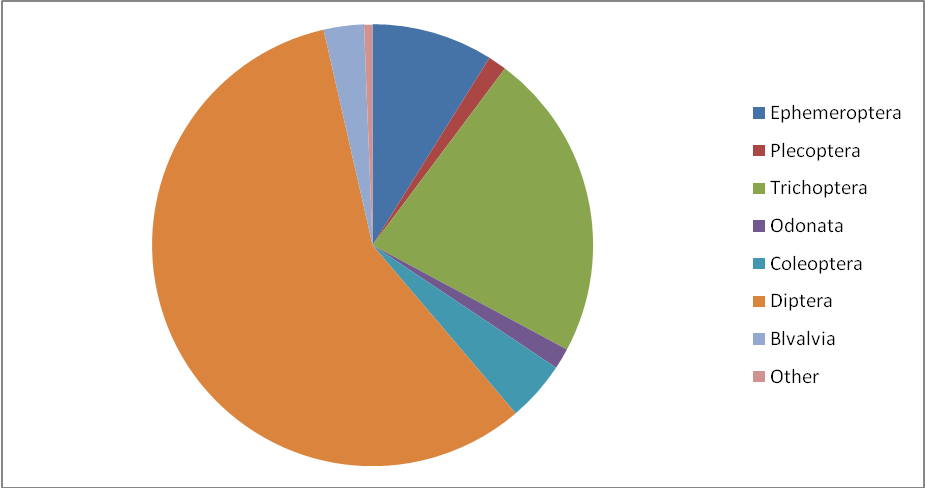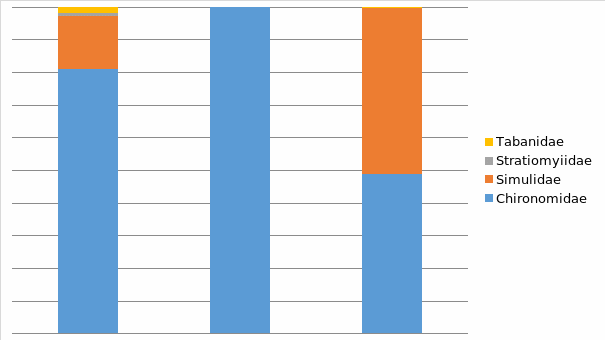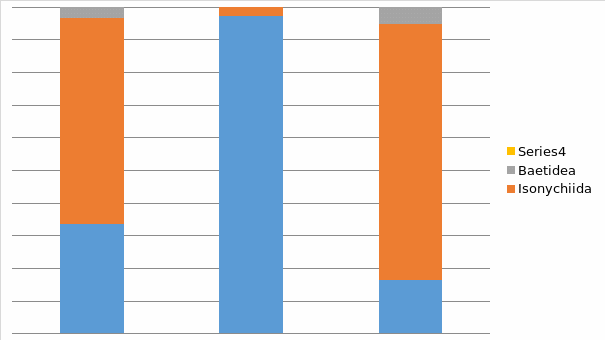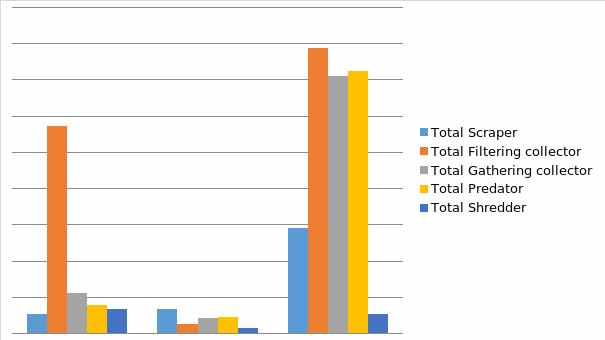Abstract
The sampling of Macroinvertebrate constitutes a very important aspect of analyzing a habitat due to the fact that Microinvertebrates are fundamentally vital in defining the health of streams where they habour. Equally, they indicate the condition to which a habitat can be access as well as enable a clear definition of the quality of water where they exist.
This report is an attempt to analyze data which was obtained from three(3) varying bench-Macbroinvertebrate samples which were gathered from over a one hundred and fifty meter unit creek from Dento, Texas. A three minute kick net sample was collected every 50 meters along the reach and then brought back to the lab for processing. The variety of Macroinvertebrate along each transect was compared in pie graphs. More varied habitats in transect tended to produce greater variety in the sample.
Several aquatic insect are known of as indicators of a good stream-health such as Ephemeroptera, Trichoptera, and Diptera. A high variety of aquatic Macroinvertebrate are indicators of a high quality stream. Benthic Macroinvertebrate studied are useful to determine anthropogenic alterations of a stream’s ecosystem from pollution. Therefore, it is important to study the results of Macroinvertebrate samples to understand better what is going on in a stream.
Introduction
The general knowledge of stream-ecology is built round studying activity in running-water especially as expressed by the symbioses of organisms and their adoptability and interactions with their habitat. It may be viewed through the interchange of energy physically, biologically, and chemically between the organisms and their habitat in a chain structure (Larson & Pat, 1997; Poole & Berman 2001; Uneme, 2008).
The chemical aspect of the chain involves dissolve and absorb of gases, solids and the circling of nutrients within an organizational circle or an ecosystem which may encapsulate the presence of chlorophyll in periphyton or microorganism on CPOM.
The physical aspect of the process has to do with eco-regions such as watersheds landforms and to some extent, climatic conditions (Gauge, 2009)). The biological aspect of the chain is the organisms themselves which are able to cause a change on their environment through their day to day interaction with same (Frenchman, 2004; Emeka, 2011).
By the interaction, there is interdependence on organisms on others. Very recognizable in the chain are Macroinvertebrates. The paper will study Macroinvertebrates sampling as a very vital component of analyzable habitat. The study is made relevant by the significance of Microinvertebrates to health indications in streams. Dodds (2002) has also linked the significance to indications of same to habitat conditions as well as to water-quality.
The study thus presents a report in provision of a summarized data gathered from three varying benthic-macroinvertabrate specimens that were accessed at over one hundred and fifty meters reach of a Denton creek in Texas. A three minute kick net sample was collected every 50 meters along each the reach and then brought back to the lab for processing. The variety of Macroinvertebrate along each transect was compared in pie graphs. More varied habitats in transect tended to produce greater variety in the sample.
Several aquatic insect are found to be indicators of a good stream health such as Ephemeroptera, Trichoptera, and Diptera. A high variety of aquatic Macroinvertebrate are indicators of a high quality stream. Benthic Macroinvertebrate studied are useful to determine anthropogenic alterations of a stream’s ecosystem from pollution. Therefore, it is important to study the results of Macroinvertebrate samples to understand better what is going on in a stream.
Aim of the Study
The aim of this study is to determine anthropogenic alterations of a stream ecosystem from pollution.
Material and Methods
Material
The materials for the study include Benthic Macroinvertebrate samples that were collected at clear creek, Denton Co. Texas, on February 17, 2011 from 12:15pm to 4:00pm. Clear creek is the local stream for Denton, Texas. It is located at Latitude 33°20’10”, Longitude 97°10’45” NAD2 with the drainage area 295 square miles.
Benthic Macroinvertebrate sampling indicator was used to identify the stream quality. Insects present in the stream were considered as an indicator of the stream’s healthy. Macroinvertebrate are divided into different groups based on feeding habits. It is called functional feeding groups. The categorization is based on food preference and tolerance. Tolerance standards are assigned to organisms that are known as pollution indicators. Some insects are very sensitive to the pollution such as Ephemeroptera, Trichoptera, and Plecoptera.
Function feeding groups introduce a clear picture of nutrient availability (Allan, 1995). The classification of function feeding groups is collectors (filtering and gathering), predators, shredders, and scrapers. They feed on course particulate-organic-matter (CPOM) and on fine-particulate-organic-matter (FPOM) (Boulton, & Margaret, 1999).
Table 1. Material we used in Clear Creek.
Methods
- Appropriate sampling techniques were made use of in the collection of samples for 3 different habitats.
- Samples were put into white enamel pan.
- Force was used to remove all orgasms from pan and ¼ of the sample was PUT in a petri-dish.
- Collection of the number in each FFG and add in the labels was done.
- Labels were included in the collection site, data, and habitat. And,
- Measure FFG ratios from totals for each habitat types.
Results and Dissection
Results
The result has been presented in table 2 below and futher analyzed in figure 1, 2, 3 and 4.
Table 2. Count of Texas organized by functional feeding group at clear Cleek.




Table 3. Functional Feeding Group ratios for each transect and evaluation of reach based on ecosystem parameter criteria (Hydro-Québec, 2006).
Table 1 contains the raw data for functional feeding groups, organized by transect (1, 2 and 3).The numbers for transects are summed for a reach total. Figure 4 shows the abundance of organism in each feeding group by transect number and for the whole reach. Filtering collector in transects 1 and 3, and Scraper in transect 2 and 3 are more abundant than all other groups. Shredders are most common in transect 1 and 3, but are found in comparatively low numbers at Transects 2. Predator are more common in transect 1 and 3.
Discussion
Filtering collectors are most common in transects 1 and 3. Their abundance had a large riffle spanning the entre channel. Scrapers are most common in transect 2 and 3. Gathering collector are most common in transect 3 (Figure 4). Transects 2 and 3 had large amount of aquatic macrophytes, which often serve as traps for FPOM. Transects 1 and 3 had many numbers of Simuliidae. This transects also had large riffles with high flow. Simuliidae require high flowing water for oxygen.
Both types of collectors comprise about 70% of the organisms in the reach, but the dominant collectors were different in each transect. Transects 2 and 3 had approximately equal proportions of gathering and filtering collectors. In transect 1, total number of Filtering collectors is more than gathering collectors. Transect 3 was overwhelmingly populated with hundred of filtering collectors, most of which were Simuliidae (Figure 2).
The reach had about equal proportions and numbers of filtering and gathering collectors due to the large numbers of Tricorythidae and Simuliide. Gatherers were must abundant whether sediments could deposit in the macrophytes beds, while filterers were more common where large areas of fast-flowing water were available. Indeed transect 2 (which had no riffles) also had the lowest amount and proportion of filtering collectors.
Scarapers were most common in all transects. They feed on organic microlayers (Allen, 2007). Hydroptilidae found in transects 1 and 3 that could be eating algae. Algae are most important food of Hydroptilidae ). Heptageniidae were the dominate scraper in all transects. This family is adapted for clinging to surface with its tarsal claws. This family are found in the gravel (Transects 1 and 3) and cobble (transect 2) habitat. Therefore, these kinds of habitat are good for scraper.
Conclusion and Recommendations
Conclusion
The paper has studied Macroinvertebrates sampling as a very vital component of analyzable habitat. The study is made relevant based on the significance of Microinvertebrates to health indications in streams. This is also linked with the significance to indications of same to habitat conditions as well as to water-quality.
The study thus presents a report in provision of summarized data gathered from three varying benthic-macroinvertabrate specimens that were accessed at over one hundred and fifty meters reach of a Denton creek in Texas
Recommendations
Sampling is a veritable tool in determining anthropogenic alterations of a stream ecosystem from pollution. It could generate better results in a situation whereby large data is collected.
Reference List
Allan, J. (1995). Stream Ecology: Structure and Function of Running Waters. London, U.K.: Chapman & Hall.
Boulton, A., & Margaret, A. (1999). Australian Freshwater Ecology: Processes and Management. Glen Osmond, South Australia: Gleneagles Publishing.
Dodds, W. (2002). Freshwater Ecology Concepts and Environmental Applications. San Diego, CA: Academic Press.
Emeka, H. (2011). A Handbook on Ecology. Ibadan: University Press.
Frenchman, U. (2004). Life in the Oceans. New york: brigth way house.
Gauge, F. (2009). The World of Insects. Accra: Favour Press.
Hydro-Québec. (2006). A review of Statistical Methods for the Evaluation of Aquatic Habitat Suitability for in stream flow Assessment. Wiley InterScience, 22, 503-523.
Larson, L., & Pat, A. (1997). The Natural Heating and Cooling of Water. Rangelands, 19, 6–8.
Poole, G., & Berman, C. (2001). An Ecological Perspective on In-stream Temperature: Natural Heat Dynamics and Mechanisms of Human-caused Thermal Degradation. Environmental Management, 27, 787–802.
Uneme, T. (2008). Modern Biology for Schools. Ibadan: University Press.